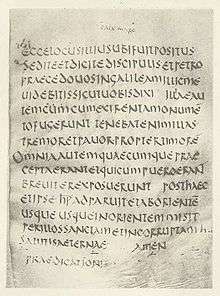Codex Bobiensis

Codex Bobiensis (k) is a fragmentary Latin manuscript of the Bible. Specifically, it is an example of a Vetus Latina Bible, the type used from the 2nd century until Jerome's Latin translation, the Vulgate, was written in the 4th century. The text contains parts of the Gospel of Mark (Mk 8:8-"shorter ending") and Gospel of Matthew (Mt 1:1-15:36). The order of books was probably: John, Luke, Mark, and Matthew.[1]
It is from North Africa, and is dated to the 4th or 5th century. Later, it was brought to the monastery in Bobbio in northern Italy. It was traditionally assigned to St. Columban, who died in the monastery he had founded there, in 615.[1] Today it is housed in the national library in Turin.
Researchers, comparing the Codex Bobiensis with quotes from Cyprian’s publications from the 3rd century, think it may represent a page from the Bible Cyprian used while he was a bishop in Carthage.
A palaeographic study of the scripture determined it is a copy of a papyrus script from the 2nd century. Codex Bobiensis is the only known copy that has the addition of Mark 16:9's "short ending", but not the "long ending" through Mark 16:20 which is present in the vast majority of manuscripts, and is considered indicative of the Byzantine text-type. This is the only known example of the "shorter ending" added directly to Mark 16:8.[2]
The Latin text of the codex is a representative of the Western text-type.
Textual features
In Matthew 8:12 it represents textual variant ἐξελεύσονται (will go out) instead of ἐκβληθήσονται (will be thrown). This variant is supported only by two Greek manuscripts Codex Sinaiticus, Codex Climaci Rescriptus, and by syrc, s, p, pal, arm, Diatessaron.[3]
In Mark 16:3 it has unusual additional text:
ab osteo? Subito autem ad horam tertiam tenebrae diei factae sunt per totum orbem terrae, et descenderunt de caelis angeli et surgent (-ntes?, nte eo?, surgit?) in claritate vivi Dei (viri duo? + et) simul ascenderunt cum eo, et continuo lux facta est. Tunc illae accesserunt ad monimentum.[4]
"from the earthquake? But suddenly, through the whole world until the third hour of the day darkness was made over all the earth, and were come down from heaven angels And there shall arise (Riseth?) In the clarity of the living God (two men? + And) at the same time went up with him, and once the light was made. Then she went to the sepulcher."
Codex Bobiensis has led to speculation that the Gospel of Mark was originally written in Latin and not Greek. It is one of the oldest preserved examples of the Gospel of Mark, and Mark was supposedly traveling in Africa after having written his Gospel.
See also
References
- 1 2 F. H. A. Scrivener, A Plain Introduction to the Criticism of the New Testament (London 1894), vol. 2, p. 48.
- ↑ K. Aland & B. Aland, The text of the New Testament: an introduction to the critical editions and to the Theory and Practice of the Modern Textual Criticism, Wm. Eerdmans, 1995, p. 188
- ↑ UBS4, p. 26.
- ↑ Eberhard Nestle, Erwin Nestle, Barbara Aland and Kurt Aland (eds), Novum Testamentum Graece, 26th edition, (Stuttgart: Deutsche Bibelgesellschaft, 1991), p. 146.
Further reading
- John Wordsworth, Old Latin Biblical Texts, Oxford 1886
- F. C. Burkitt, Notes. Saint Mark XV in codex k, JTS 1900, ss. 278-279.
- F. C. Burkitt, Further Notes on codex k, JTS 1904, ss. 100-107.
- C. H. Turner, A Re-collation of Codex k, JTS 1904, pp. 88-100.
External links and sources
- Bible Research: Codex Bobbiensis
- Catholic Planet: The Writing of the Gospels – Mark
- BIBLE VIEWS: Christian Doctrine and Practice: Translations and the Greek Text
- Image